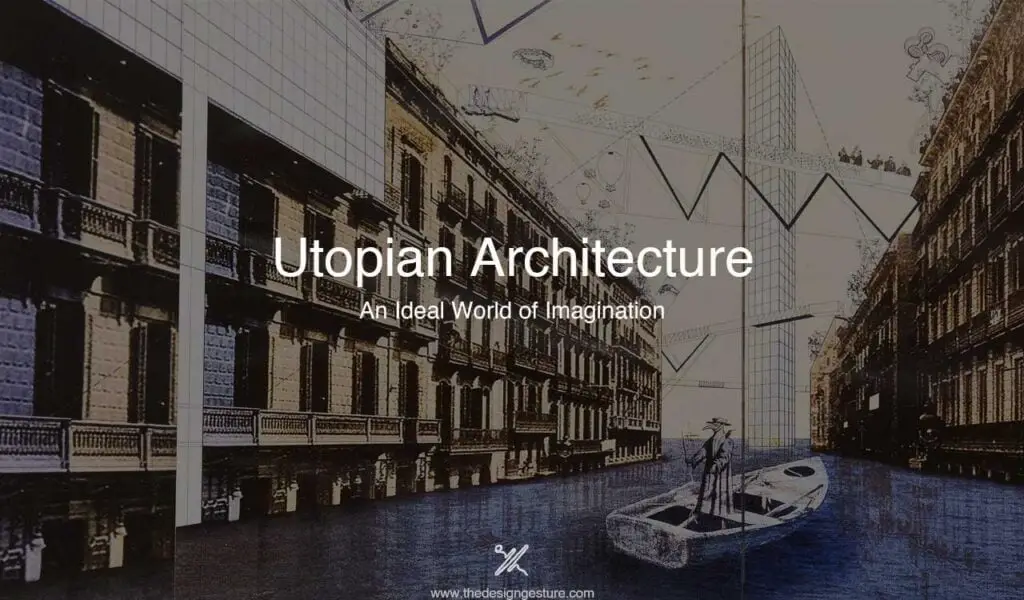Table of Contents
Introduction
The existence of Utopian architecture is only imagined being a part of science fiction and contemporary fantasy. There is a large genre of books and movies that provides us with a perspective on extravagant architecture sparking a new lifestyle. The notion of utopian ways in the world of architecture was through the ideas and beliefs of a self-sufficient, independent, cohesive plan to create an environment that could manage the current global crisis.
The utopian architecture was mostly developed to manage issues of over, population, improve sustainable living, or simply incorporate discipline in planning. There is no one explanation of physical characteristics or common design aspects across the range of utopian architecture and designs. Utopian Architecture is experienced and is depended upon the experience of the user. Utopia is an idealization of real-life to escape from reality. Utopian architecture is a limitless world of imagination.
What is Utopian architecture?
Utopia was a term devised by Thomas More in 1516, in his book with the same name. The word “utopia” comes from the Greek word ou-topos, which means no place or specifically “nowhere” but also implies eu-topos, meaning “a good place.” Utopian is used to define civil or religious views which claim that it is potentially possible to create a new and perfect world in which each person is satisfied and happy. The utopian vision of nature in its richest form and the interdependence and harmony of humans as well as nature.
Utopia offers people an illusion of perfection. Utopian architecture is a way to imagine a world where no difficulties exist, where the entirety is perfect. Utopian architecture is a way to work towards the improvement of society. Initially, utopian designers and theorists were known as futurists. They sought to form a society propelled by technological advancements through time. Few architects and theorists put aesthetics on the back burner, while practicality and services were given more importance.
Experimental examples of Utopian architecture
Progress City – Walt Disney Utopia
In 1966, Disney declared his plan to build Epcot, an abbreviation for “Experimental Prototype Community of Tomorrow.” Disney wanted to create “a living blueprint for the future” which was unlike anywhere else in the world and build an entire new city built from scratch.
Disney wanted to establish the entire set-up of his new community and build a place according to his plans, designs, and ideas, rather than drawing on a pre-existing town. His vision was a futuristic one with a circular city aesthetic based on a radical plan mostly proposed by Le Corbusier, in which the city would expand outward from EPCOT’s center, making it the focus, with each external layer having its theme. EPCOT was said to have an airport that would enable anyone to fly straight to Disney World, while a vacation land would offer resort lodgings for visitors. However, the idea was abandoned after his death and the only pieces of Epcot remain.
Charles Fourier’s Phalanstere
Charles Fourier was a French social theorist who advocated a rebuilding of society based upon communal associations of creators known as Phalanges or the Phalanxes. A Phalanstère was a type of structure intended for a self-contained, self-sufficient, and self-reliant utopian community, preferably consisting of 500–2000 people working together for mutual benefit, progress, and development in the early 19th century.
Palmanova, Italy
Palmanova is a town and community in northeast Italy. Palmanova town is an example of the main highlight of the late Renaissance, built up by the Venetian Republic in 1593. Palmanova was meant to be a utopia occupied by self-sustaining merchants, craftsmen, and farmers to create a mutually developing environment. The designers incorporate geometrical harmony into their design, believing that beauty strengthens the wellness of a society.
Ordos, China
The Ordos is also known as the ghost city of China. Ordos Kangbashi was said to be a modern city of top-notch architecture, extravagant public plazas with international-scale stadiums, and an enormous spread of new housing established in the barren deserts of China’s Inner Mongolia in less than a decade. The Ordos Developers shortly scaled back the concept city to hold many people. The Ordos never reached its early idea of existence due to elevated property taxes and poor construction inhibiting people from settling in the Ordos.
Seaside, Florida
The setting for the movie, The Truman Show, like Poertmeirion, Seaside, Florida, is a planned community built by Robert S. David. Davis had the intention of building a town based on a relaxed lifestyle and communal spirit. The emphasis of the community was to be directed towards the central square with its community and public facilities.
Seaside was developed with precision by a selection of architects and created eclectic streetscapes. Considered by some to be a ‘resort garden suburb. The city was designed to be too perfect, which lacked history and base while trying to be based upon authentic traditional architecture styles like Victorian, Neoclassical, Modern, Postmodern, and Deconstructivism.
Plan Voisin: Le Corbusier’s utopian idea to demolish Paris
Plan Voisin was a planned redevelopment of Paris designed by French-Swiss architect Le Corbusier in 1925. Le Corbusier often recommended demolishing old towns and leaving only the most important monuments standings. Le Corbusier’s unfulfilled dream was to reorganize the soul of Paris. Le Corbusier planned to dismantle the city center in the north of the Seine River, where he planned to build a spacious estate. The idea of recreating Plan Voisin was drawn from his Radial City Theory.
Drop City, Colorado
Drop City was intended to be an artists’ community that was established in southern Colorado in 1960. Drop City comprised of around 14-20 inhabitants whose major artistic yield took the form of the buildings. Drop City became known as the initial rural hippie community. Drop City’s founders ultimately sold the land. Drop City community no longer exists, but the spirit of Drop City’s old dome structures has endured. Drop City was formed with the concept to create a reasonable co-housing community. Richert, an award-winning artist, paints brightly colored acrylics with parallel lines, shadows, and multidimensional, rhombus-like shapes evocative of geodesic domes still draws inspiration from the Drop City.
Portmeirion, Wales
Portmeirion is a tourist village in Gwynedd, North Wales. Portmeirion was designed and built by Sir Clough Williams-Ellis, who acquired the land in the 1920s and maintained to create this imaginative wonderland up until the 1970s with an Italian influence in architecture. The colors used on the walls are a mix of vibrant Meditteranean-inspired hues with shades of pastel. It has a style somewhere between a model village and a theme park and although the tacky detail is unarguably it is blended with an attractive, organic layout.
Auroville, India
Auroville was founded in 1968 by Mirra Alfassa and designed by architect Roger Anger. Auroville was an experimental township in Viluppuram district, mostly in the state of Tamil Nadu, India. Auroville was meant to be a universal town where people of all countries can live in peace and progressive harmony, all politics, and all nationalities. The objective of Auroville was to make everyone understand to live in unity and peace.
Conclusion
Utopian architecture is a dream or sometimes even unrealistic way for people who want to create such a city to live in. It is sometimes a delusional concept to move society forward to find solutions to problems like overpopulation, resource use, and even urban planning. The developments of current technology could give us the way to generate a Utopian society. Utopian belief in architecture is more important, especially now, in socio-political and economic relations, whether it be whimsically polemical or philosophically plausible and implementable in today’s world. A utopian vision is more about dodging reality to deal with the current crises of the world.
Utopian architecture provides not just people but architects and designers to spread their wings to utilize new and out-the-box ideas to create a world of their whims. There have been many ideas, theories and concepts that have been developed by architects, designers, and theorists about urban and city development. Utopian architecture could include convincing accounts of potential outcomes and people’s desires rooted in stories prone to new challenges. But the conceptual and imaginative limit of these claims and narratives may not support a strong foundation for certainty. Utopian architecture can be very useful, but it is very difficult to implement it in today’s world where technology is limited and even people don’t seem to understand the need.




